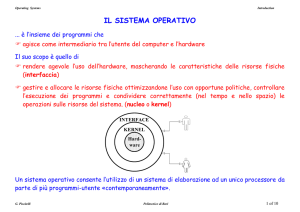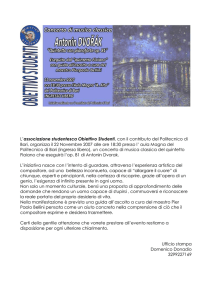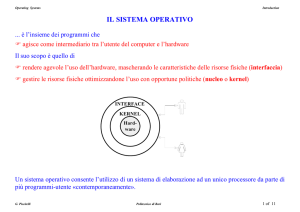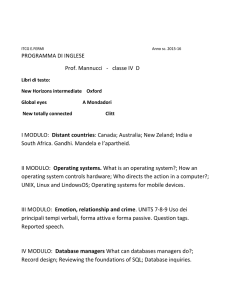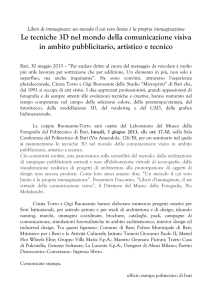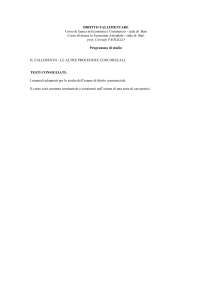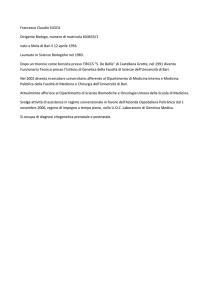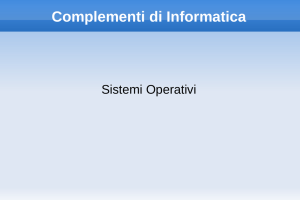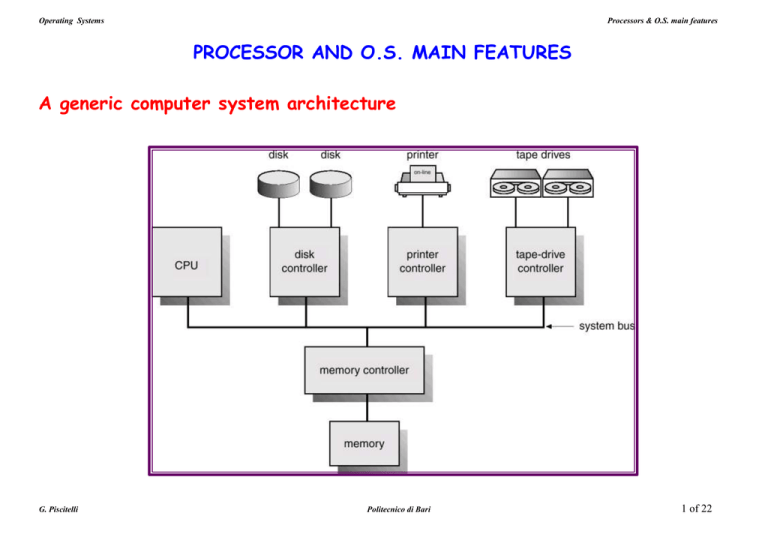
Operating Systems
Processors & O.S. main features
PROCESSOR AND O.S. MAIN FEATURES
A generic computer system architecture
G. Piscitelli
Politecnico di Bari
1 of 22
Operating Systems
Processors & O.S. main features
PROCESSOR AND O.S. MAIN FEATURES
A generic computer system operation
The initial program (bootstrap program) stored in the ROM initializes the
system (registers, controllers, memory).
Then localizes, locates and loads into memory the kernel, starting the first
process (initiator) and waiting for some event to occurr.
An event is usually signaled by an interrupt from either the hardware or the
software.
The O.S. is interrupt driven.
Hardware may trigger an interrupt by sending a signal to the CPU.
Software may trigger an interrupt by executing a supervisor call (SVC).
G. Piscitelli
Politecnico di Bari
2 of 22
Operating Systems
Processors & O.S. main features
HARDWARE PROTECTION
Dual-Mode Operation
Sharing system resources requires operating system to ensure that an incorrect program
cannot cause other programs to execute incorrectly.
Provide hardware support to differentiate between at least two modes of operations.
1. User mode – execution done on behalf of a user.
2. Monitor mode (also kernel mode or system mode) – execution done on behalf of operating
system.
Mode bit added to computer hardware to show the current mode: monitor (0) or user (1).
When an interrupt or fault occurs hardware switches to monitor mode.
Privileged instructions can be issued only in monitor mode.
G. Piscitelli
Politecnico di Bari
3 of 22
Operating Systems
Processors & O.S. main features
HARDWARE PROTECTION
I/O Protection
All I/O instructions are privileged instructions.
Must ensure that a user program could never gain control of the computer in monitor
mode (i.e., a user program that, as part of its execution, stores a new address in the
interrupt vector).
G. Piscitelli
Politecnico di Bari
4 of 22
Operating Systems
Processors & O.S. main features
PROCESSOR AND O.S. MAIN FEATURES
Tipi di interruzioni
Interruzione interna (o trap): è quella generata dal software ed è causata da un
errore (divisione per zero, indirizzo errato di memoria) o dalla richiesta di un
servizio del S.O. Ha carattere sincrono, in quanto il processo che lancia la trap
va nello stato di wait provocando l'avvio di un segmento di codice del nucleo del
sistema operativo (Supervisor Call o SVC).
Interruzione esterna (o interrupt): ha carattere asincrono, in quanto al
verificarsi di un evento, la sua occorrenza è segnalata alla CPU tramite un
segnale in ragione del quale viene provocato l’avvio di un segmento di codice del
nucleo del sistema operativo.
Ogni processore ha una propria architettura di SVC ed interrupt, anche se le
diverse architetture hanno molte caratteristiche in comune.
G. Piscitelli
Politecnico di Bari
5 of 22
Operating Systems
Processors & O.S. main features
PROCESSOR AND O.S. MAIN FEATURES
SVC operation
System calls provide the interface between a running program and the
operating system.
Generally available as assembly-language instructions.
Languages defined to replace assembly language for systems programming allow
system calls to be made directly (e.g., C, C++)
Three general methods are used to pass parameters between a running
program and the operating system.
Pass parameters in registers.
Store the parameters in a table in memory, and the table address is passed as a
parameter in a register.
Push (store) the parameters onto the stack by the program, and pop off the stack
by operating system.
G. Piscitelli
Politecnico di Bari
6 of 22
Operating Systems
Processors & O.S. main features
PROCESSOR AND O.S. MAIN FEATURES
Interrupt operation
Interrupt transfers control to the interrupt service routine generally, through the
interrupt vector, which contains the addresses of all the service routines.
Interrupt architecture must save the address of the interrupted instruction.
Incoming interrupts are disabled (interrupt masking) while another interrupt is being
processed to prevent a lost interrupt.
G. Piscitelli
Politecnico di Bari
7 of 22
Operating Systems
Processors & O.S. main features
PROCESSOR AND O.S. MAIN FEATURES
Gestione di un interrupt
Ogni processore ha un proprio meccanismo di gestione degli interrupt, sia quelli esterni
che quelli interni.
Quando avviene un’interruzione il sistema operativo preserva lo stato della CPU.
Il meccanismo più semplice prevede che quando la CPU viene interrotta, si completi
l’istruzione corrente, si salvi il contesto computazionale corrente (registri e program
counter) sullo stack del sistema e si passi a trasferire l’esecuzione all’indirizzo
specificato nell’interrupt vector, che occupa le prime posizioni di memoria e che è
costituito da tanti indirizzi quanti sono gli interrupt previsti dal processore. Ogni
indirizzo rimanda al segmento di codice che serve quel particolare interrupt.
Al termine dell’esecuzione del segmento di codice indirizzato dall’interrupt vector, si
ripristina il contesto computazionale e la CPU riprende l’esecuzione interrotta.
G. Piscitelli
Politecnico di Bari
8 of 22
Operating Systems
Processors & O.S. main features
PROCESSOR AND O.S. MAIN FEATURES
Invocazione del sistema operativo
Dato che le istruzioni di I/O sono privilegiate, come può il programma utente eseguire
dell’I/O?
Attraverso le system call, il metodo con cui un processo richiede un’azione da parte del
sistema operativo:
–
Solitamente sono un interrupt software (trap)
–
Il controllo passa attraverso il vettore di interrupt alla routine di servizio della trap
nel sistema operativo, e il mode bit viene impostato a “monitor”.
–
Il sistema operativo verifica che i parametri siano legali e corretti, esegue la
richiesta, e ritorna il controllo all’istruzione che segue la system call.
–
con l’istruzione di ritorno, il mode bit viene impostato a “user”
G. Piscitelli
Politecnico di Bari
9 of 22
Operating Systems
Processors & O.S. main features
OPERAZIONI DEI SISTEMI DI CALCOLO
•
I dispositivi di I/O e la CPU possono funzionare concorrentemente
•
Ogni controller di dispositivo gestisce un particolare tipo di dispositivo.
•
Ogni controller ha un buffer locale
•
La CPU muove dati da/per la memoria principale per/da i buffer locali dei controller
•
l’I/O avviene tra il dispositivo e il buffer locale del controller
•
Il controller informa la CPU al termine della sua operazione, generando un interrupt.
G. Piscitelli
Politecnico di Bari
10 of 22
Operating Systems
Processors & O.S. main features
PROCESSOR AND O.S. MAIN FEATURES
Servicing an I/O operation
To start an I/O operation the CPU loads the appropriate registers into the device
controller.
The device controller examines the content of the registers to determin the action to
take and starts the requested transfer of data. The I/O operation may be accomplished
in two different ways: Synchronous or asynchronous I/O.
Once the transfer is completed, the controller sends an interrupt to the CPU to signal it
has finished the requested operation.
G. Piscitelli
Politecnico di Bari
11 of 22
Operating Systems
Processors & O.S. main features
PROCESSOR AND O.S. MAIN FEATURES
Synchronous and asynchronous I/O
(a) Synchronous method
After I/O starts, control returns to user program only upon I/O completion.
A special wait instruction idles the CPU until the next interrupt or a tight wait
loop (busy wait) continues until an interrupt occurs, transferring control to
another part of the O.S. (contention for memory access).
At most one I/O request is outstanding at a time, no simultaneous I/O
processing.
(b) Asynchronous method
After I/O starts, control returns to user program without waiting for I/O
completion.
A system call is requested to allow user to wait for I/O completion.
G. Piscitelli
If no user or O.S. process needs for CPU, a wait instruction or wait loop is
requested
Politecnico di Bari
12 of 22
Operating Systems
Processors & O.S. main features
PROCESSOR AND O.S. MAIN FEATURES
Synchronous and asynchronous I/O
G. Piscitelli
Politecnico di Bari
13 of 22
Operating Systems
Processors & O.S. main features
PROCESSOR AND O.S. MAIN FEATURES
Device Status Table
To override the problem of the wait instruction or of the tight loop, and to be able to keep
track of many I/O requests at the same time, the O.S. uses a table, the Device Status table,
containing an entry for each I/O device.
The O.S. indexes into I/O device table to determine device status and to modify table entry
to include interrupt.
Device-status table contains entry for each I/O device indicating its type, address, and state.
G. Piscitelli
Politecnico di Bari
14 of 22
Operating Systems
Processors & O.S. main features
PROCESSOR AND O.S. MAIN FEATURES
Direct Memory Access (DMA)
Used for high-speed I/O devices, to avoid programmed I/O for large data movement.
Able to transmit information at close to memory speeds.
Device controller transfers blocks of data from buffer storage directly to main
memory without CPU intervention.
Only one interrupt is generated per block, rather than the one interrupt per byte.
G. Piscitelli
Politecnico di Bari
15 of 22
Operating Systems
Processors & O.S. main features
MEMORY TYPES
Main memory – only large storage media that the CPU can access directly.
Secondary storage – extension of main memory that provides large nonvolatile storage
capacity.
Most
common
secondary
storage:
Magnetic disks made from rigid metal or
glass platters covered with ironmagnetic recording material
Disk surface is logically divided into tracks,
which are subdivided into sectors.
The disk controller determines the logical
interaction between the device and the
computer.
G. Piscitelli
Politecnico di Bari
16 of 22
Operating Systems
Processors & O.S. main features
STORAGE DEVICE HIERARCHY
I sistemi di
memorizzazione sono
organizzati
gerarchicamente, secondo
velocità, costo e volatilità.
G. Piscitelli
Politecnico di Bari
17 of 22
Operating Systems
Processors & O.S. main features
STORAGE DEVICE HIERARCHY
G. Piscitelli
Politecnico di Bari
18 of 22
Operating Systems
Processors & O.S. main features
CACHE MEMORY
Use of high-speed memory to hold recently-accessed data.
Requires a cache management policy.
Caching introduces another level in storage hierarchy. This requires data that is
simultaneously stored in more than one level to be consistent.
Una cache memory serve a duplicare i dati più frequentemente usati di una memoria, in
una memoria più veloce.
La memoria principale può essere vista come una cache per la memoria secondaria.
G. Piscitelli
Politecnico di Bari
19 of 22
Operating Systems
Processors & O.S. main features
HARDWARE PROTECTION
Memory Protection
Must provide memory protection at least for the interrupt vector and the interrupt
service routines.
In order to have memory protection, add two registers that determine the range of
legal addresses a program may access:
Base register – holds the smallest legal physical memory address.
Limit register – contains the size of the range
Memory outside the defined range is protected.
G. Piscitelli
Politecnico di Bari
20 of 22
Operating Systems
Processors & O.S. main features
HARDWARE PROTECTION
Memory Protection
Essendo eseguito in modo monitor, il sistema operativo ha libero accesso a tutta la
memoria, sia di sistema sia utente
Le istruzioni di caricamento dei registri base e limite sono privilegiate
G. Piscitelli
Politecnico di Bari
21 of 22
Operating Systems
Processors & O.S. main features
HARDWARE PROTECTION
CPU Protection
Timer – interrupts computer after specified period to ensure operating system
maintains control.
Timer is decremented every clock tick (1/50 of second, commonly).
When timer reaches the value 0, an interrupt occurs.
Timer commonly used to implement time sharing.
Time also used to compute the current time.
Load-timer is a privileged instruction.
G. Piscitelli
Politecnico di Bari
22 of 22

